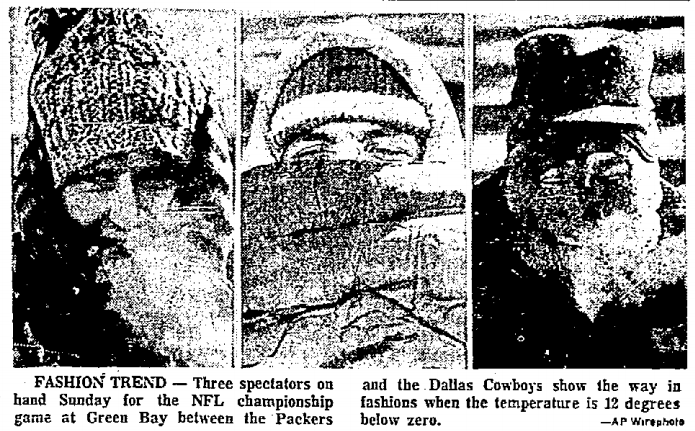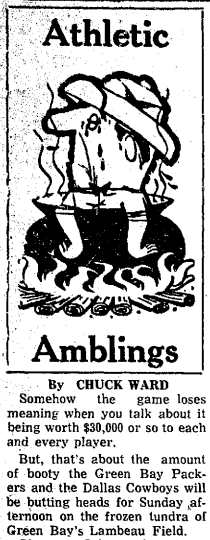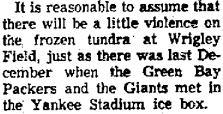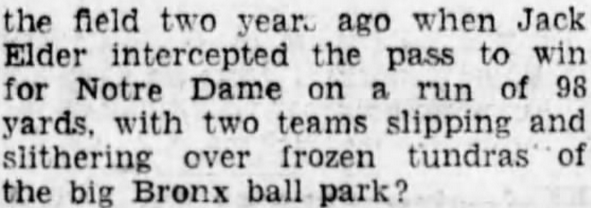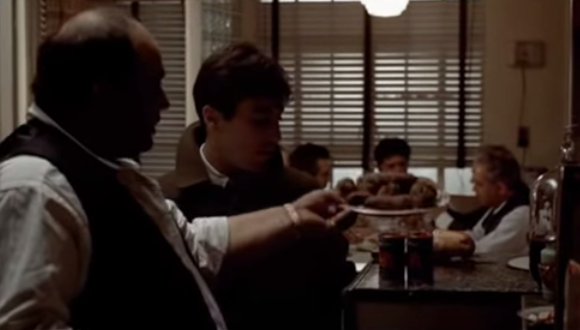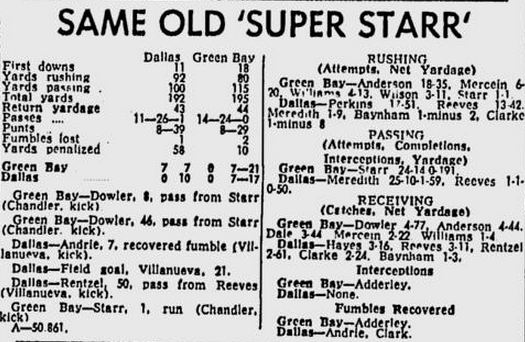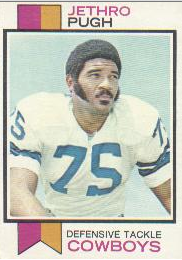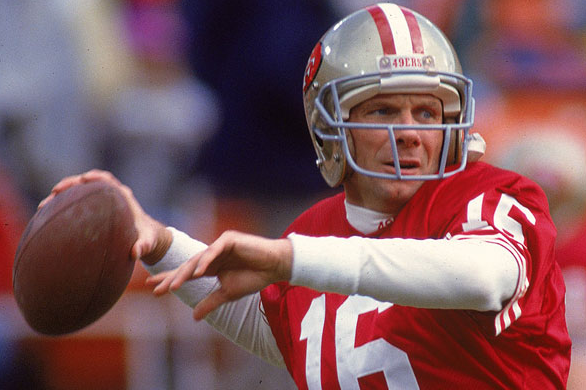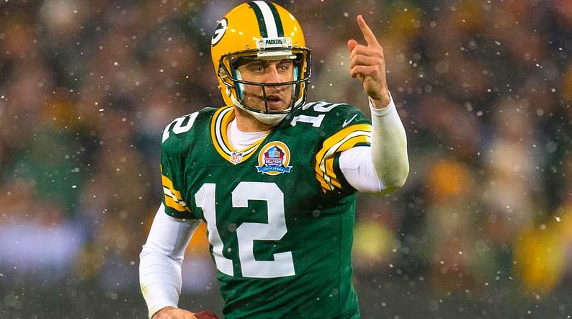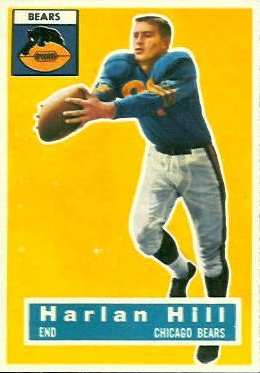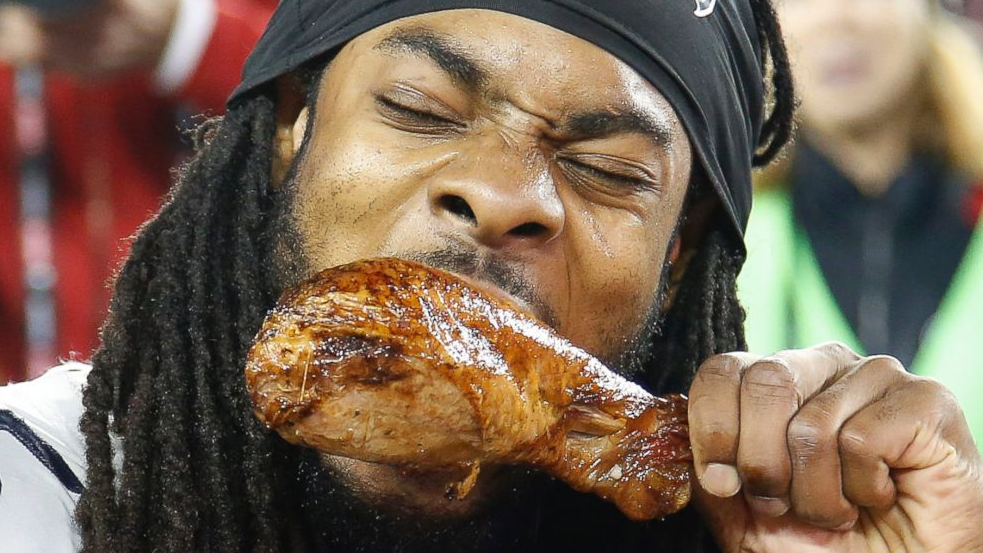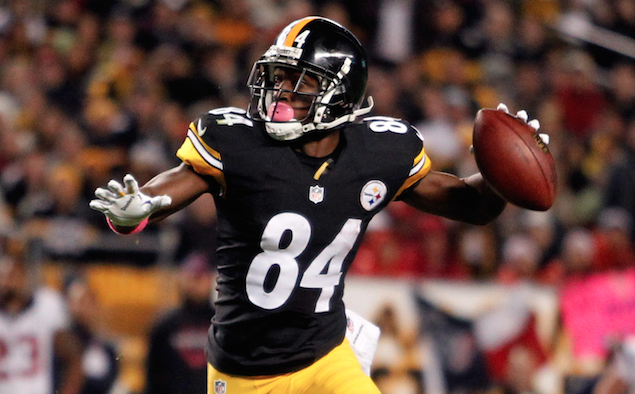The Ice Bowl is so much bigger now, in memory, than it was in real time. Oh, it got plenty of coverage from TV and print, but it was still, let’s not forget, 1967. Pro football had yet to overtake baseball as America’s No. 1 sport — according to the Gallup people, at least — and other events that holiday week, such as the next day’s New Year’s bowl games, also got their share of attention.
Consider: Arthur Daley, The New York Times’ Pulitzer Prize winner, didn’t make the trip to Green Bay. Instead, he wrote about the Packers-Cowboys classic back in the newsroom (or wherever he did his typing) – for the Jan. 2 edition. Jim Murray of the Los Angeles Times was a no-show, too. He was busy gearing up for the Rose Bowl between O.J. Simpson’s USC Trojans and the Indiana Hoosiers. It was that way with a lot of newspapers. They might have sent their NFL guy to Wisconsin but not necessarily a columnist.
Another such paper was The Boston Globe, but at least it had a decent excuse: Boston was an AFL town, home of the Patriots. For a pinch-hit voice, the Globe picked up Red Smith’s syndicated column, but get this: It chopped off the last six paragraphs – for “space” reasons, presumably.
Imagine having a Mount Rushmore writer like Smith covering the game for you, a guy who grew up in Green Bay, for goodness sakes, and cutting the bottom third of his column. Not exactly one of your Great Moments in Sportswriting History. (Fortunately, the Globe recovered nicely in the decades that followed.)
A writer or two did make it to the Great White North, though – some, possibly, by dogsled or snowmobile – and it’s their deathless prose that follows. Who cares if Murray tossed off some funny lines later (e.g. “The theory could be advanced that neither team had the advantage because it was cold for the Packers, too. That’s like saying that the shark had no advantage over the swimmer because both were in water.”)? He wasn’t there.
In fact, let’s see if I can put together a composite piece that tells the story of the game from multiple points of view. We’ll start with the hometown boy, Walter Wellesley Smith:
GREEN BAY – On the eve of the game, Henry Jordan and his bride called on the Jerry Kramers.
“Nervous?” said the [Packers] defensive tackle. “Naw. I just keep hollering at Olive.”
Jerry grinned toward the sofa where the wives were chatting. “I keep calling her Jethro,” he said.
If Jethro Pugh was stomping through Kramer’s dreams all last week, Pugh and his violent accomplices in the Dallas defensive line will be haunting Bart Starr for weeks to come, but Bart will be having his nightmares under a Miami moon. Starr bought the Packers tickets to the site of the Jan. 14 Stupor Bowl Sunday with a one-yard plunge that snatched the championship of the National Football League from the Cowboys’ frozen fingers just 13 seconds before the end of the 35th annual title game.
Shirley Povich, Washington Post:
The Cowboys won the toss and there was some hope they would elect to call the whole thing off, but they didn’t and pretty soon the Packers had a touchdown and a 7-0 lead. They were favored with three penalties against the Cowboys on the drive and from the Dallas 8, Bart Starr taught the Cowboys a simple lesson in metrics. He sent 6-foot-5 Boyd Dowler into the territory of 5-11 defender Mike Johnson and pitched to Dowler in the end zone.
The sheer audacity of Starr got the Packers another touchdown in the second quarter. First thing, it was third and 1 on the Dallas 43 and not a passing down. Certainly not a long-bomb situation.
How bodacious can a quarterback get? Starr put a long-stemmed beauty up in the air and if it came down before it congealed up there the Packers would have a touchdown, because Dowler had five yards on Mel Renfro. The re-entry was perfect, and the Packers had a 14-0 lead. This was making a terrible prophet out of Clint Murchison, the billionaire owner of the Cowboys who was saying before the contest, “It is too cold for the Green Bay passing game, and we will win with our running.” As a football sage he was proving only to be a genius of finance. His own man, Don Meredith, was passing badly and it was apparent that only on the Dallas side of the field was the temperature below zero.
Sam Blair, Dallas Morning News:
When two penguins sauntered into the hotel drug store and bought hot water bottles, when waitresses ice-skated across the coffee shop to serve breakfast, when Admiral Byrd fetched out bags and carried them to the taxi, it really became obvious. All of us – the Cowboys, the Packers, the fans, the press – were trapped in a situation which the sports world had never experienced before. . . .
This was No Man’s weather. . . . No sporting event, with the possible exception of the Winter Olympics, ever had been contested in such brutal coldness. . . . “I have never been so numb or hurt so much from hitting,” [Green Bay linebacker Lee Roy] Caffey shuddered. “I’m just glad I didn’t have to try to catch a ball out there. I might have gotten broken fingers.”
Tex Schramm, Sports Illustrated:
[The Cowboys] got one touchdown back later in the second quarter when the very quick Dallas line, which punished Starr most of the afternoon – he was dumped eight times while attempting to pass – threw him for a 19-yard loss. End Willie Townes hit Starr and forced a fumble; the other end, George Andrie, picked up the ball and scored with it.
“It wasn’t the offensive line breaking down,” Starr said after the game. “They did well enough. But the receivers couldn’t make their cuts on the icy field, and I couldn’t find anyone to throw to. So I was holding the ball too long, and they got to me.”
A little later, the usually sure-handed Willie Wood dropped a punt on the Green Bay 17 and Phil Clark recovered for Dallas. Danny Villanueva kicked a 21-yard field goal just before the half, and the Cowboys, who had been unable to gain more than three first downs in the first half, nonetheless left the field trailing only 14-10.
Bob St. John, Dallas Morning News:
This loss to the Packers hurt even more than last year’s when the Cowboys fell 34-27. Then, Dallas came within two yards of tying the game. This time they came within a hair of winning . . . due to Ol’ Reliable, the Danny Reeves to Lance Rentzel halfback pass.
The Cowboys, trailing 14-10, stood at midfield on the first play of the final period. Both Packer[s] right cornerback Bob Jeter and free safety Willie Wood are all-pro, which speaks for itself. But each one is extremely active coming up to play the run. Wood, in fact, though he is a safety, often comes up to force the play. Willie came up when Reeves started wide to his left. So did Jeter, who should have stayed on Rentzel. Lance took off. Reeves stopped and lofted a perfect pass, of course, which Rentzel ran under between the 15-20 and outraced the other safety, Tom Brown, for the TD.
Lloyd Larsen, Milwaukee Sentinel:
Many may insist that the Packers were lucky to pull this one out of the sub-zero atmosphere. But that would be unfair to a group of men who played like champions when only championship performance would suffice.
I’m thinking, of course, of that final 68-yard drive, on which Starr, Chuck Mercein, Donny Anderson, Boyd Dowler and their teammates on the offensive unit collaborated under pressure as pressure is seldom experienced by athletes.
They had less than five minutes to do the job. And they just made it by the skin of their teeth. That pay-off touchdown “pop” by Starr was a just reward for a great guy whose fumble had put the Cowboys on the scoreboard for the first time. That bobble was the one everybody would have remembered. But it’s different now. And that, I maintain, is a triumph for justice.
Alan Goldstein, Baltimore Sun:
The Packers give you the impression that they will find a way to win no matter how impossible the odds. But even such a hard-seasoned veteran as [Jerry] Kramer admitted that a few doubts entered his mind with the Cowboys leading, 17-14, late in the fourth period.
“We got the ball with about five minutes left,” the rugged offensive guard recalled, “and I was thinking: Well, maybe this is the year we don’t pull it off, that it will all end here. But I know every guy made up his mind that we were going to go down swinging.
“Well, when we finally got down to the 1-yard line and missed on our first two tries, Bart took a little more time than usual in the huddle explaining what he wanted to do. [That is, sneak it in himself.] And the last thing he told us was, ‘And we darn well better make it.’ “

